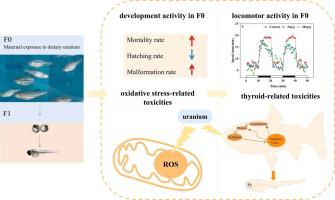Ecotoxicology and Environmental Safety ( IF 6.2 ) Pub Date : 2023-09-28 , DOI: 10.1016/j.ecoenv.2023.115501 Chao Xu 1 , Honghong Gong 1 , Lili Niu 2 , Tianyang Li 1 , Hangqin Guo 1 , Chenjian Hu 3 , Xiaohui Sun 4 , Ling Li 5 , Weiping Liu 6

|
The contamination of uranium in aquatic ecosystems has raised growing global concern. However, the understanding of its chronic effects on aquatic organisms is limited, particularly with regards to transgenerational toxicity. In this study, we evaluated the maternal transfer risk of uranium using zebrafish. Sexually mature female zebrafish were exposed to 2 and 20 ng/g of uranium-spiked food for 28 days. The induced bioconcentration, thyroid disruption, and oxidative stress in both the adults (F0) and their embryos (F1) were further investigated. Element analysis showed that uranium was present in both F0 and F1, with higher concentrations observed in F1, indicating significant maternal offloading to the offspring. Meanwhile, an increased malformation and decreased swim speed were observed in the F1. Thyroid hormone analysis revealed significant decreases in the levels of triiodothyronine (T3) in both the F0 adults and F1 embryos, but thyroxine (T4) was not significantly affected. Additionally, the activities of antioxidant defenses, including catalase (CAT) and superoxide dismutase (SOD), and the expression of glutathione (GSH) and malondialdehyde (MDA) were significantly altered in the F0 and F1 larvae at 120 hpf. The hypothalamic-pituitary-thyroid (HPT) axis, oxidative stress, and apoptosis-related gene transcription expression were also significantly affected in both generations. Taken together, these findings highlight the importance of considering maternal transfer in uranium risk assessments.
中文翻译:

母亲接触膳食铀会导致斑马鱼后代氧化应激和甲状腺破坏
水生生态系统中的铀污染日益引起全球关注。然而,对其对水生生物的慢性影响的了解有限,特别是在跨代毒性方面。在这项研究中,我们利用斑马鱼评估了铀的母体转移风险。性成熟的雌性斑马鱼分别接触 2 ng/g 和 20 ng/g 的加铀食物 28 天。进一步研究了成人 (F0) 及其胚胎 (F1) 中诱导的生物浓缩、甲状腺破坏和氧化应激。元素分析显示,F0 和 F1 中均存在铀,且 F1 中观察到的浓度较高,表明母体向后代转移了显着的铀。同时,在 F1 中观察到畸形增加和游泳速度下降。甲状腺激素分析显示,F0 成虫和 F1 胚胎中的三碘甲状腺原氨酸 (T3) 水平显着下降,但甲状腺素 (T4) 并未受到显着影响。此外,在 120 hpf 时,F0 和 F1 幼虫的抗氧化防御活性,包括过氧化氢酶 (CAT) 和超氧化物歧化酶 (SOD),以及谷胱甘肽 (GSH) 和丙二醛 (MDA) 的表达显着改变。下丘脑-垂体-甲状腺(HPT)轴、氧化应激和凋亡相关基因转录表达在两代人中也受到显着影响。总而言之,这些发现凸显了在铀风险评估中考虑孕产妇转移的重要性。


















































 京公网安备 11010802027423号
京公网安备 11010802027423号